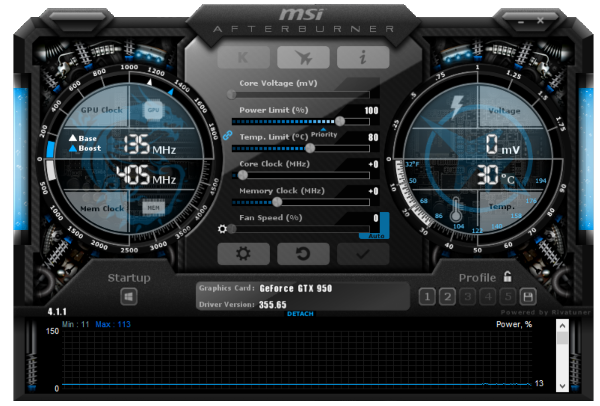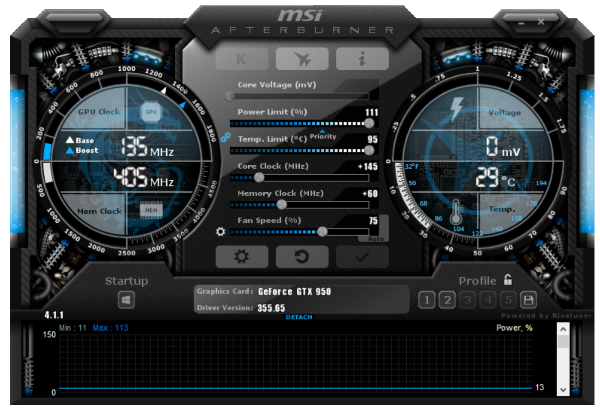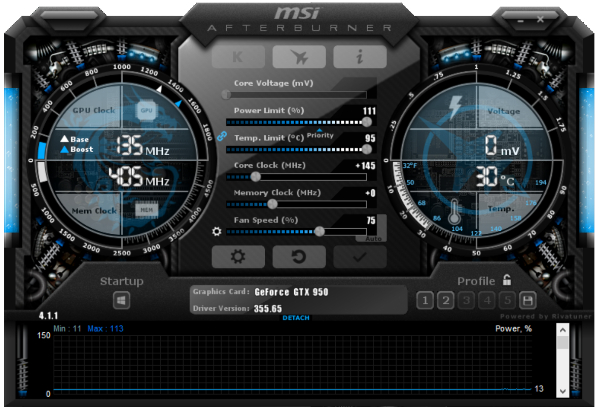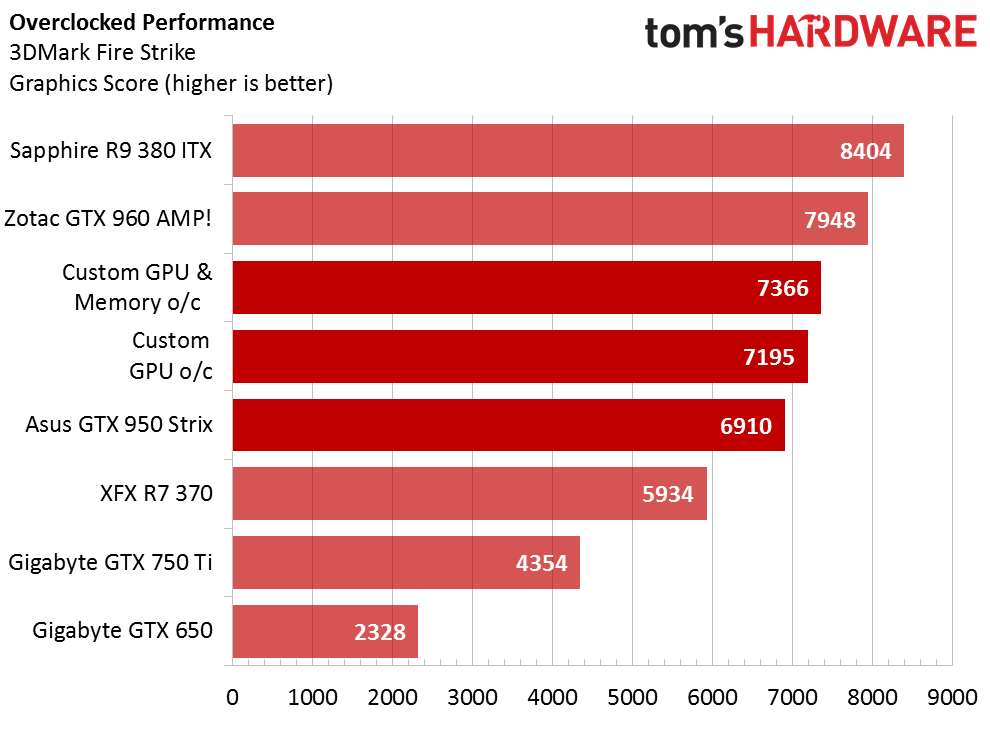Asus GeForce GTX 950 Strix Review
Today we get our first look at Nvidia's latest GPU in Asus' GeForce GTX 950 Strix.
Why you can trust Tom's Hardware
Overclocking
If you’ve read one of my graphics card reviews, my disclaimer will be familiar. Our results should not be used as anything but an example; every GPU is slightly different. And try not to make drastic changes to the GPU or memory clocks. Small increments are key.
The first thing I do when I overclock a GPU is max out its power limit. In the case of the GTX 950, this setting can be boosted to 111%, which also increases the temperature limit from 80 to 95 degrees. Before modifying anything else, a baseline test was run using 3DMark Fire Strike. The same test was run with the power limit red-lined to ensure the extra power didn’t introduce any issues.
I like to start with 10MHz increments on the core and move down to 5MHz if I manage to surpass a 100MHz overclock. With this card, I was a little bit braver and started with 25MHz changes. My justification came from Nvidia’s reviewer’s guide: in internal testing, it found that most samples will hit 1400MHz without any voltage adjustments or extreme cooling. Nvidia actively encouraged reviewers to push their samples to see what they can do.
Nvidia's statement gave me the courage to try more aggressive increments. In the end, that sped up the process considerably because the peak overclock ended up being 145MHz over the stock clock rate. Once I hit +125MHz, the increments were lowered to 5MHz. Using this method, the GPU proved to be stable up to 1300MHz, which increased up to 1500MHz via GPU Boost.
After finding the maximum stable GPU overclock, I moved on to adjusting the memory. Tuning in 10MHz increments ended up being a wise choice. This particular sample wasn’t happy with data rates beyond its stock setting. I wasn't particularly surprised since Asus already uses an aggressive clock rate. The most I could get out of it and still maintain stability was +60MHz or 1710MHz, which is effectively 6840 MT/s. Considering higher-end GPUs are paired with 7010 MT/s memory, the best-binned memory chips are likely reserved for those cards.
In almost all tests, the adjusted GPU and memory clock rates yielded decent gains over the stock configuration. Occasionally, the results land Nvidia's GeForce GTX 950 in line with the higher-end GTX 960.
Get Tom's Hardware's best news and in-depth reviews, straight to your inbox.
Kevin Carbotte is a contributing writer for Tom's Hardware who primarily covers VR and AR hardware. He has been writing for us for more than four years.
-
g-unit1111 So how does this compare in price to the GTX 960? If it's lower by about $20 - $30 I would think this card would be selling like hot cakes.Reply -
Math Geek very interesting looking card. nvidia has been doing a lot of this lately offering almost the same performance for less money than a pretty new card. it indeed looks like an awesome budget card well above the 750ti and almost as good as the 960 for a lot less.Reply
will be very interested in the other versions of this that show up. nvidia trumps amd yet again. *sigh* when will the carnage end?? please amd do something to stay relevant!!! -
Math Geek ReplySo how does this compare in price to the GTX 960? If it's lower by about $20 - $30 I would think this card would be selling like hot cakes.
article says about $160 so more like $40 less than the amp edition they compared it to. however, with prices at $175 or so on the low end it is closer to an average of $20 or so price drop. which is why he states the 960 should lose the recommendation to this card since it is almost the same performance for a less. if your goal is 1080p at decent frames according to this review there is little reason to spend the extra money on the 960 over the 950. if course this is only price speculation. once they are out, the price will drop more than likely making this even more of a good deal. -
InvalidError This might be the final nail in most of AMD's rebadged products coffins. If my HD5770 decided to die on me in the near future, I would seriously consider the GTX950.Reply -
Math Geek on the high end amd still looks ok with the new stuff but the mid to low end they are clearly not taking the nod at any price point. next gpu chart will probably be all nvidia until the very end when it might dual suggest the 390 with the 970........ maybe......Reply -
Onus I noticed some inconsistencies in the charts; sometimes the GTX750Ti is there, sometimes it isn't. To me, this is the card the GTX950 replaces, although I am disappointed it needs a 6-pin power connector.Reply
The card does look like a winner though, and reinforces a lesson I've ignored to the detriment of my wallet more than once; for a single monitor, $150-$175 is all that needs to be spent on a graphics card in order to get good settings for games.
I have to agree with the sentiment that AMD better get its tail in gear if they want to remain relevant.
-
kcarbotte ReplyI noticed some inconsistencies in the charts; sometimes the GTX750Ti is there, sometimes it isn't. To me, this is the card the GTX950 replaces, although I am disappointed it needs a 6-pin power connector.
The card does look like a winner though, and reinforces a lesson I've ignored to the detriment of my wallet more than once; for a single monitor, $150-$175 is all that needs to be spent on a graphics card in order to get good settings for games.
I have to agree with the sentiment that AMD better get its tail in gear if they want to remain relevant.
I went through the charts. Looks like the only one missing 750ti is Metro at 1080p. I've requested the image be amended. FYI: min 30, avg 39.625, max 54 on the 750ti.
Nvidia has moved the 750ti to the lower price point, but keeping it on the market.
The 950 isn't being positioned by Nvidia as an upgrade from the 750ti, as the performance isn't a big enough jump for most consumers to make the change.
It is however a notable improvement in performance over a 750ti. -
kcarbotte ReplySo how does this compare in price to the GTX 960? If it's lower by about $20 - $30 I would think this card would be selling like hot cakes.
article says about $160 so more like $40 less than the amp edition they compared it to. however, with prices at $175 or so on the low end it is closer to an average of $20 or so price drop. which is why he states the 960 should lose the recommendation to this card since it is almost the same performance for a less. if your goal is 1080p at decent frames according to this review there is little reason to spend the extra money on the 960 over the 950. if course this is only price speculation. once they are out, the price will drop more than likely making this even more of a good deal.
Bingo.
There's very little reason to get a GTX 960 over a 950 at this point in my view. The extra money, albeit only $40 or so, would be better served in a different component, or on a game.
-
logainofhades Reply16493184 said:I noticed some inconsistencies in the charts; sometimes the GTX750Ti is there, sometimes it isn't. To me, this is the card the GTX950 replaces, although I am disappointed it needs a 6-pin power connector.
The card does look like a winner though, and reinforces a lesson I've ignored to the detriment of my wallet more than once; for a single monitor, $150-$175 is all that needs to be spent on a graphics card in order to get good settings for games.
I have to agree with the sentiment that AMD better get its tail in gear if they want to remain relevant.
Maybe that card will be a 940?



